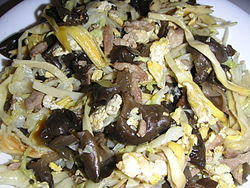Mu shu pork
| Moo shu pork | |||||||
 |
|||||||
| Traditional Chinese | or | ||||||
|---|---|---|---|---|---|---|---|
| Simplified Chinese | or | ||||||
| Hanyu Pinyin | mù xū ròu or mù xī ròu | ||||||
|
|||||||
| Transcriptions | |
|---|---|
| Standard Mandarin | |
| Hanyu Pinyin | mù xū ròu or mù xī ròu |
Moo shu pork (also spelled mù xū ròu, moo shi pork, mu shu or mu xu pork) is a dish of northern Chinese origin, possibly originating from Shandong. It is believed to have first appeared on the menus of Chinese restaurants in the United States in the late 1960s, and is also a staple of American Chinese cuisine.
In its traditional Chinese version, moo shu pork (木须肉 / mùxūròu) consists of sliced pork tenderloin, cucumber, and scrambled eggs, stir fried in sesame or peanut oil together with thinly sliced wood ear mushrooms (black fungus) and enokitake mushrooms. The dish is seasoned with minced ginger and garlic, scallions, soy sauce, and rice cooking wine (usually huangjiu).
In the United States, the dish seems to have appeared in Chinese restaurants in New York City and Washington, D.C., in approximately 1966, receiving mention in a New York Times guide to Washington, D.C., restaurants published in that year. One of the first restaurants in Manhattan to serve the dish was Pearl's, one of the best known New York City Chinese restaurants to serve non-Cantonese food in the 1960s. A 1967 article in The New York Times states that another of the first restaurateurs to serve the dish in Manhattan was Emily Kwoh, the owner of the Mandarin House, Mandarin East, and Great Shanghai restaurants. The dish was also early on the menu at Joyce Chen's, a celebrated pioneering Mandarin-style restaurant in Cambridge, Massachusetts. At that time, the dish was at first prepared in a traditional manner, but, as wood ears and day lily buds were scarce, a modified recipe was developed. In this modified recipe, which gradually came to predominate in North America, green cabbage is usually the predominant ingredient, along with scrambled eggs, carrots, day lily buds, wood ear mushrooms, scallions, and bean sprouts. The new recipe is more like the filling of Chinese Spring pancake. Shiitake mushrooms, bok choy, snow pea pods, bell peppers, onions, and celery are sometimes also used, and dry sherry is often substituted for the huangjiu. The vegetables (except the day lily buds and bean sprouts) are generally sliced into long, thin strips before cooking.
...
Wikipedia
